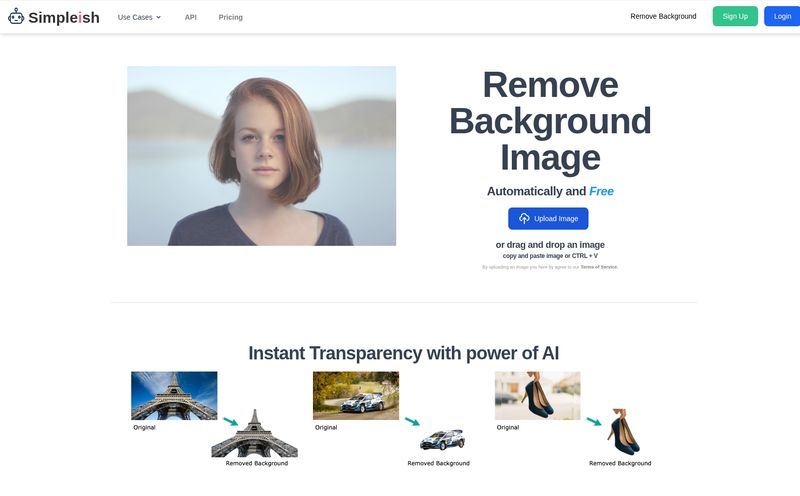Let’s have a little chat. Just you and me, fellow website builders, SEOs, and digital hoarders. We’ve all been there. Staring at a PageSpeed Insights score that looks more like a cry for help than a metric of success. The culprit, nine times out of ten? Images. Great big, beautiful, unoptimized images that load slower than a dial-up modem in 1998.
For years, the solution was a tedious, multi-step dance: export from Photoshop, run it through a compressor tool like TinyPNG, upload to WordPress, and then maybe, just maybe, use another plugin to generate responsive sizes. It’s a chore. A boring, soul-sucking chore.
So when I first heard about PixelBin.io, I was skeptical. Another “AI-powered solution” that promises to revolutionize everything? Yawn. We hear that every week. But then I looked a little closer, and my professional curiosity got the better of me. This isn't just another image squisher. It’s trying to be something more. A central command for all your visual assets. And I have to say… I’m intrigued.
So What Is PixelBin.io, Really?
Let's cut through the marketing jargon. At its heart, PixelBin.io is an all-in-one platform for your digital media. Think of it as a combination of a super-smart image editor, a hyper-organized library, and a lightning-fast delivery network. It’s what’s known as a Digital Asset Management (DAM) platform, but with a heavy dose of artificial intelligence baked right in.
Instead of your images living in a chaotic mess of folders on your server, Dropbox, and some random intern's hard drive, they all live in one central, organized place. From there, you can manipulate, optimize, and serve them to your website or app on the fly. It's less of a tool and more of an infrastructure upgrade.
The AI Magic Tricks That Actually Save Time
This is the part that gets all the attention, and for good reason. The AI features here aren't just gimmicks; they’re genuine time-savers that replace tasks I used to pay a freelance designer for.
Effortless Background and Object Removal
Ever spent 20 minutes meticulously tracing a product in Photoshop just to get a clean background? PixelBin does it with a click. For e-commerce stores, this is an absolute godsend. The consistency you can achieve across thousands of product photos is incredible. It also handles watermark removal, which, while ethically… grey… can be a lifesaver when you’ve lost the original source file for an old image you have the rights to.
Intelligent Upscaling and Enhancement
We’ve all been handed a postage-stamp-sized logo by a client and told to “make it bigger.” Usually, that means a blurry, pixelated mess. PixelBin’s AI upscaling is surprisingly good, using machine learning to intelligently fill in the gaps and produce a larger, sharper image. It’s not actual magic, but it’s pretty darn close.
Visit PixelBin.io
Let's Talk SEO: Core Web Vitals and Blazing Speed
Okay, time to put on my SEO hat. This is where a platform like PixelBin can either justify its existence or fall flat. And I'm happy to report, it's a huge win for performance.
Google's Core Web Vitals are no longer a suggestion; they're a significant ranking factor. Your Largest Contentful Paint (LCP), which is heavily influenced by how fast your main image loads, is critical. PixelBin tackles this in two ways:
- Automatic Optimization: It doesn’t just compress images. It analyzes them and converts them to next-gen formats like WebP or AVIF, which offer better quality at a smaller file size. This is done on-the-fly, serving the best format for the user's browser.
- A Global CDN: This is huge. Having your images served from a Content Delivery Network means they are loaded from a server physically closer to your visitor. A user in London gets the image from a London server, not one in Los Angeles. The result is a dramatic reduction in latency and a massive boost to load times.
For any site, but especially for image-heavy ones like portfolios or online stores, these two features alone can be the difference between a passing and failing CWV grade.
The Unsung Hero: Proper Digital Asset Management
I know, I know, “Digital Asset Management” sounds like a boring corporate term. But stick with me. Remember that chaos of folders I mentioned? The DAM part of PixelBin is the cure. It’s the Marie Kondo for your digital life.
Having a single source of truth for every image, video, and brand asset is transformative. No more asking, “Hey, do you have the latest logo?” No more accidentally using an outdated product photo. Everything is tagged, searchable, and version-controlled. You can create different transformations of a single master image without creating a dozen duplicate files. Need a square thumbnail, a 16:9 banner, and a grayscale version? You don't create three files; you just create three transformation rules for the one master file. It’s cleaner, more efficient, and just plain smarter.
The PixelBin.io Pricing: Is It Worth The Cost?
Alright, the all-important question: what’s this going to cost me? This is often where these amazing platforms fall apart for smaller businesses. PixelBin has a pretty flexible structure, moving from a free tier to custom enterprise solutions. Here's a simplified look based on their current plans:
| Plan | Price | Best For |
|---|---|---|
| Free Plan | $0 / month | Trying out the platform, very small personal projects. Includes a small number of credits. |
| Pay as you go | Starts at $19 (one-time) | Occasional users or small businesses who need more than the free plan but don't want a subscription. |
| Lite Plan | $49 / month | Small to medium businesses with regular image needs and moderate traffic. |
| Pro Plan | $219 / month | High-traffic websites, e-commerce stores, and teams needing advanced features and more bandwidth. |
| Enterprise | Custom | Large-scale operations with specific needs for security, support, and custom integrations. |
Note: This pricing is based on information available at the time of writing. Please check the official PixelBin website for the most current details.
The cost might seem steep compared to a $29 one-time plugin, but that’s the wrong comparison. You aren't just buying a plugin. You're buying an entire workflow and delivery infrastructure. For a business generating revenue, the cost is easily justified by the time saved and the performance gains, which can directly impact conversions and search rankings.
My Honest Take: The Good and The Not-So-Good
What I Really Like
Frankly, the biggest win is the consolidation. Having one place to handle optimization, transformations, storage, and delivery is a workflow dream. The AI tools are genuinely useful and go way beyond simple compression. The impact on Core Web Vitals and site speed is undeniable, and the developer-friendly APIs mean it can grow with a business's needs.
Things to Keep In Mind
Of course, its not a magic wand. For someone who just runs a small personal blog, the pricing could be a bit much. There’s also a bit of a learning curve. It's more involved than just installing a plugin. You have to change how you think about handling media, which can take some getting used to. And since it centralizes everything, you're putting a lot of trust into one platform—so you better be sure it's the right one for you.
Frequently Asked Questions about PixelBin
- 1. Can I use PixelBin for free?
- Yes, PixelBin offers a free plan that includes a certain number of credits and downloads. It's perfect for testing the platform's capabilities to see if it fits your needs before committing to a paid plan.
- 2. Is PixelBin.io just for developers?
- Not at all. While it has powerful SDKs and APIs for developers to build custom solutions, the web interface is user-friendly enough for marketers, content managers, and business owners to manage their assets without writing a single line of code.
- 3. How exactly does PixelBin help with SEO?
- It directly improves your technical SEO by tackling Core Web Vitals. It automatically creates and serves lightweight, next-gen image formats (like WebP) and delivers them through a global CDN. This makes your images load much faster, which is a major factor for Google's LCP score and overall user experience.
- 4. Is it better than a standard image compression plugin?
- It's a completely different beast. A compression plugin just makes your image files smaller. PixelBin is a comprehensive Digital Asset Management (DAM) system. It compresses, transforms with AI, stores, organizes, and delivers your images via a CDN. It’s a full-stack solution, not a single-feature tool.
- 5. What happens if I use all my credits on a paid plan?
- Most plans will allow you to either purchase additional credits or will have an overage usage rate. For high-volume users, moving up to the next plan tier is often the most cost-effective option.
The Final Verdict: Is PixelBin a Worthy Investment?
After spending some real time with it, my initial skepticism has melted away. PixelBin.io isn't just another tool to add to the pile. For any business that takes its online presence seriously—especially e-commerce, media sites, and marketing agencies—it feels less like a cost and more like an investment.
It’s an investment in speed, in efficiency, and in sanity. It's a way to finally tame the chaos of digital media and turn your image library from a liability into a high-performing asset. If you're still fighting the good fight with a dozen different tools, I’d say give their free plan a spin. You might just be surprised.
Reference and Sources
- PixelBin.io Official Website
- PixelBin.io Official Pricing Page
- More information on Core Web Vitals from Google



